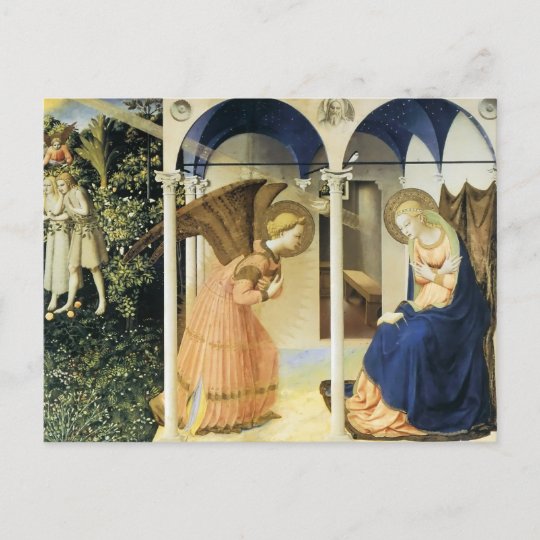Fray angelico la anunciacion
annunciation of cortonapainting by fra angelico
The Annunciation, in this painting, which is the central part of an altarpiece, two scenes are represented, which are related by the fact that God expelled Adam and Eve from Eden, but promised them that He would bring them a Messiah; hence the sunbeam coming from the scene on the left (expulsion from paradise) with the hand of God, descends and shines directly towards the face of Mary, who will be the mother of the Savior announced by God.
The use of the colors blue and gold indicates a wealthy client, as both colors are made from semi-precious minerals and are very expensive to produce. Another allusion to the powerful client is the treatment of the garden, without depth or perspective, which imitates the background of a tapestry, like those imported from Brussels at that time.
The pictorial technique used by the author in the work is tempera on panel. To prepare the panel, a process called priming is carried out, which consists of first smoothing the panel and giving it a layer of glue to cover its pores. On top of this, a layer of plaster mixed with water or glue is applied, resulting in a white background. On this, the preparatory drawing is made and then painting with pigments dissolved in water and tempered or thickened with egg, casein, gum, or a solution of glycerin.
fra angelico anunciación cortona
La Anunciación del Prado es un retablo pintado por Giovanni da Fiesole, conocido actualmente como Fra Angelico, en la década de 1420. La obra es uno de los tres retablos de Fra Angelico que representan la Anunciación; los otros dos son la Anunciación de Cortona y la Anunciación de San Giovanni Valdarno. No se sabe con certeza el orden en que se pintaron las tres obras, pero el consenso histórico general sitúa la versión del Prado en primer lugar.
La obra fue pintada para un altar lateral del convento de San Domenico, en Fiesole, donde Fra Angelico era fraile. Para la misma iglesia también contribuyó con el retablo principal, que muestra a la Virgen y el Niño entronizados con santos dominicos (c. 1425) y la Coronación de la Virgen, ahora en el Louvre (c. 1424-1435) .
La Anunciación permaneció en San Domenico hasta 1611, cuando fue vendida al rey de España y llevada a Madrid, donde pasó a formar parte de las colecciones reales de la monarquía española antes de trasladarse al Prado.
Fray angelico la anunciacion 2021
Fra Angelico is an Italian Renaissance painter, who was also a Dominican friar. When he joined the order, he changed his name to Fra Giovanni da Fiesole, or Father John of Fiesole. He was later nicknamed Fra Beato Angelico, or Fra Angelico. His modest piety and beautiful paintings earned him the nickname Father Angel.
Fra Angelico was influenced by the International Gothic style, by the colors of Sienna and by the work of Giotto. His work has the elements of the early Renaissance, preserving the elegant lines of Gothic painting.
the annunciation fra angelico analysis
Fra Angelico was essentially a Gothic painter, in the style of the great Giotto, but he incorporated some of the revolutionary elements that the new Florentine artists such as Masaccio, Guiberti or Donatello had begun to develop; such is the case of the central perspective and the naturalistic foreshortenings. Even so, his art never ceased to be characterized by simplicity in the resolution of his subjects and economy of means, without any kind of technical ostentation or ostentation. He painted with humility and awareness since, after all, he surely considered himself only a messenger of the divine word made image.
The Virgin is shown humble and submissive, seated with her arms crossed over her chest, in a gesture of greeting and slight awe at the appearance of the archangel who announces her transcendent destiny, who also crosses his arms over his chest as a respectful greeting. On the right leg of the virgin there is an open book, which indicates that she was reading and meditating on the sacred scriptures at the moment that the angel appears to her. All of the above was painted following the description of the Gospel of St. Luke, in which the scene is described as follows.










Más historias
Mejores estudios de interiorismo en Madrid
La evolución del espacio: áreas multifuncionales
Decorar con césped artificial: un estilo innovador para mentes creativas